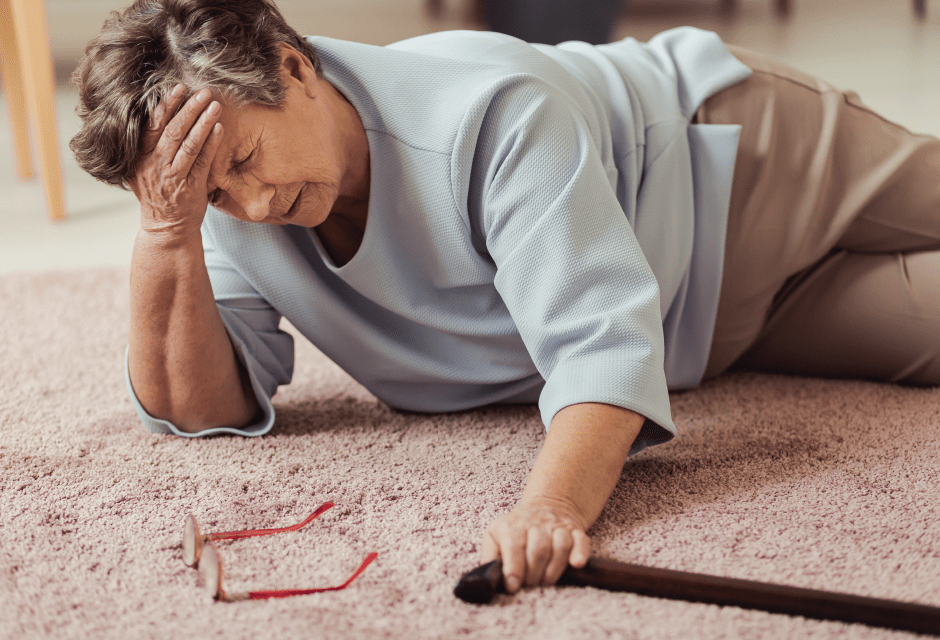Make the best senior care decision

Hip Fractures in Elderly Adults: Prevention and Treatment

Hip fractures in the elderly are common. In fact, more than 300,000 adults 65 or older are hospitalized for hip fractures each year, according to the Centers for Disease Control and Prevention (CDC). Older women are at higher risk, making up 80% of broken hips in elderly adults overall.
Let our care assessment guide you
Our free tool provides options, advice, and next steps based on your unique situation.
Why hip fractures in elderly adults are dangerous
Complications of a broken hip in elderly adults can be life-threatening. The risk of death one year after a hip fracture can range from 12% to 37% in older adults, according to statistics published by Mount Sinai School of Medicine. Mortality risks are especially high for people with another health condition or cognitive impairment, people who opt for hip fracture treatment without surgery, and people who can’t walk independently.
A broken hip severely affects mobility in seniors. When elderly adults aren’t mobile for an extended period of time, they can develop serious conditions such as:
- Blood clots in the legs or lungs
- Pneumonia
- Urinary tract infections
- Bedsores
A broken hip in the elderly can also increase their risk of falls.
Risk factors for broken hips in elderly adults
The risk of falls increases with age, and 95% of hip fractures result from a fall, according to the CDC.
“Seniors fall because they lose their coordination,” says Dr. Charles Peterson, an orthopedic surgeon at the Orthopedic Specialists of Seattle. “They have difficulty with their eyesight and balance, and they become weak. When they fall, they tend to have a higher frequency of fractures because of osteoporosis and weaker bones.”
Risk factors for hip fractures in elderly adults include:
- Osteoporosis. This condition causes the bones to weaken, making them more likely to break.
- Gender. Women are more likely than men to have osteoporosis, which increases their risk of fractures.
- Medications. Certain drugs can make seniors drowsy or dizzy, increasing the risk of falls. Other medications, such as prednisone, may weaken bones and increase the risk of fractures.
- Malnutrition. Poor nutrition as a child puts you at increased risk of fractures later in life. As you age, it’s important to keep a healthy diet that includes enough calcium and vitamin D.
- Inactive lifestyle. Not getting enough physical exercise leads to weaker bones and muscles, increasing the risk of broken hips in elderly adults.
- Other medical conditions. Certain conditions — such as diabetes, an overactive thyroid, or intestinal problems — can lead to weaker bones. Mental impairment — like dementia, complications from a stroke, or Parkinson’s — can increase the risk of falls and fractures.
- Tobacco and alcohol use. Smoking and drinking too much contributes to weaker bones.
- Unsafe home environment. Trip hazards in the home, such as throw rugs and electrical wires, along with unstable furniture and poor lighting, increases a senior’s risk for falls.
- Previous hip fracture. Seniors who’ve fractured a hip before are more likely to suffer another fracture.

Let our care assessment guide you
Our free tool provides options, advice, and next steps based on your unique situation.
How to prevent hip fractures in elderly adults
You can help your aging loved one prevent hip fractures by making sure their home is safe and free of trip hazards.
- Ensure rooms are well lit. Lighting should not be too dim or too direct. Make sure light switches are accessible.
- Tack down or remove rugs and carpets to help prevent falls.
- Make bathrooms safe by adding a chair for bathing and skid-resistant mats in the shower. Install grab bars where needed. Ensure toilet seats are tall enough for easy transferring.
- Ensure chairs are stable and have arm rests.
- Safeguard against fall hazards in the kitchen. Place a rubber mat in front of the sink and use non-slip wax on the floor. Organize frequently used items so they can be easily reached on low shelves.
- Install handrails in stairways and make sure steps aren’t slippery.
You may also talk to your loved one about:
- Having regular eye checkups.
- Wearing sensible, hard-soled flat shoes.
- Being mindful of medication’s side effects.
- Talking with their doctor about supplements to increase bone density, including calcium and vitamin D.
- Staying as physically active as possible with exercises that help with balance and leg strength, such as walking regularly, gentle yoga, or tai chi.
Hip surgery in elderly adults
If your aging parent has a hip fracture, they will most likely need surgery, a hospital stay, and rehab to help with broken hip recovery.
The type of surgery your loved one will have depends on their overall health condition, the type of fracture, and its severity.
There are two main types of hip fractures:
- Femoral neck fracture. The femoral neck is right below the ball part of the ball-and-socket hip joint in the upper part of the thigh bone (femur). This type of fracture can reduce or stop the flow of blood to the broken part of the bone. Surgery is almost always needed to facilitate broken hip recovery.
- Intertrochanteric region fracture. The intertrochanteric region is just below the femoral neck, where the thigh bone juts out.
Depending on the type of fracture, methods of hip surgery in elderly adults include:
- Hip repair using screws. This type of hip surgery in elderly adults uses metal screws to hold together the broken bone. In some cases, a metal plate is placed on the femur with screws attached to it.
- Partial hip replacement. In a partial hip replacement, the doctor replaces the head and neck of the femur with a metal device. A partial hip replacement might be recommended when the patient has other health conditions that could affect broken hip recovery, or if they’re experiencing cognitive impairment that could lead to another fall.
- Total hip replacement. If your loved one needs to have a total hip replacement, the upper part of the femur and the socket in the pelvic bone will be replaced with artificial parts. Total hip replacement is usually recommended when patients have severe arthritis.
Can seniors have hip fracture treatment without surgery?
In rare instances, doctors may recommend hip fracture treatment without surgery. Your loved one might not need surgery if the bone is fractured but remains in place. Surgery might not be recommended for patients who are too sick to endure it, were unable to walk before the fracture occurred, or are terminally ill.
In these cases, treatment consists of pain management, physical therapy, and different techniques to avoid straining and putting weight on the affected hip.

Talk with a Senior Living Advisor
Our advisors help 300,000 families each year find the right senior care for their loved ones.
Broken hip recovery and rehab: what to expect
Recovery after hip surgery is a lengthy process — it’ll take some time to return to everyday activities. Your loved one will likely stay in the hospital for a few days after surgery. Physical and occupational therapy for broken hip recovery may start while your parent is still at the hospital.
Physical therapists can develop a program for your loved one to help them strengthen muscles and improve balance and mobility. Occupational therapists focus on activities of daily living that enable your parent to live as independently as possible.
Talk to the doctor to determine where to complete rehab after your parent is discharged from the hospital. You may have options — from skilled nursing facilities, to outpatient rehab at home or at an assisted living community.
Sources:
Foster, K.W. “Overview of common hip fractures in adults.” https://www.uptodate.com/contents/overview-of-common-hip-fractures-in-adults.
Morrison R.S. “Hip fractures in adults: epidemiology and medical management.” https://www.uptodate.com/contents/hip-fracture-in-adults-epidemiology-and-medical-management.
LeBlanc K.E., Muncie H.L., LeBlanc L.L. “Hip fracture: diagnosis, treatment, and secondary prevention.” American Family Physicians; 2014: https://www.aafp.org/afp/2014/0615/p945.html.
American Academy of Orthopaedic Surgeons. Hip fractures. https://orthoinfo.aaos.org/en/diseases–conditions/hip-fractures
The information contained in this article is for informational purposes only and is not intended to constitute medical, legal or financial advice or create a professional relationship between A Place for Mom and the reader. Always seek the advice of your health care provider, attorney or financial advisor with respect to any particular matter and do not act or refrain from acting on the basis of anything you have read on this site. Links to third-party websites are only for the convenience of the reader; A Place for Mom does not recommend or endorse the contents of the third-party sites.